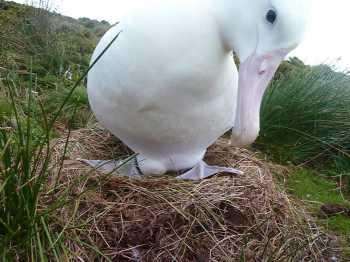Over the period 20-26 March 2012 Katrine Herian (Royal Society for the Protection of Birds Project Officer working with the Tristan Conservation Department) and Lourens Malan visited Inaccessible Island in the Tristan da Cunha Group, travelling from the main island via Nightingale Island on the National Geographic Explorer, then transferring to Tristan's Wave Dancer for the last leg. From the field hut at Blenden Hall two ascents to the island's plateau were made to survey for the presence of Tristan Albatrosses Diomedea dabbenena, known locally as Gonies.
The western plateau from Long Ridge/Cairn Peak to Gony Ridge/Swales Fell was checked on the 21st. A single Gony was seen flying over Swales Fell and along the south-west cliffs for about 15 minutes but was not sighted again. A second Gony was seen on the ground on Gony Ridge (37° 18.316'S, 012° 41.601'W at 506 m asl). This bird was confirmed on a second plateau ascent on the 23rd as an adult incubating an egg. The bird's plumage overall was very white with a little brown mottling on its crown, suggesting it is not a young bird. It was not banded and its sex is uncertain. The nest site was c. 140 m farther up the ridge (a c. 50 m rise in elevation) from last year's active nest from which it is likely that the chick that was banded in early October had fledged (click here).
An empty nest mound was seen on Cairn Peak (37° 17.904S, 012° 41.060'W; 516 m asl.) on 21 March This mound was also present in 2011 with a prospecting pair (click here) but there was evidence of activity earlier this season, shown by an increase in the amount of debris and disturbance to soil and vegetation around the site.

Photograph by Lourens Malan
Photograph by Katrine Herian
Photograph by Lourens Malan
The March 2012 incubating bird on Gony Ridge

The nest mound on Cairn Peak in March 2012
Phootgraph by Katrine Herian
Because great albatrosses of the genus Diomedea are biennial breeders it is likely that the 2012 breeding pair is not the same pair presumed to have bred successfully in 2011. Along with the Cairn Peak birds it seems that the population of Inaccessible is at least three pairs. This will make it the smallest island population of any great albatross. The next smallest population is thought to be the six pairs of Wandering Albatrosses D. exulans that are currently breeding on Australia's Macquarie Island (click here).
The Critically Endangered Tristan Albatross is endemic to the Tristan Group, with the main population of 1400-1800 annually breeding pairs occurring on Gough Island - where they remain seriously at risk to attacks from "killer mice" Mus musculus.
With thanks to Katrine Herian and Lourens Malan for information.
John Cooper, ACAP Information Officer, 15 April 2012

 Français
Français  English
English  Español
Español